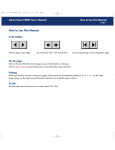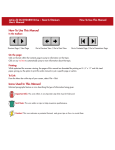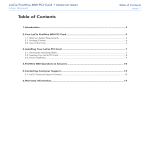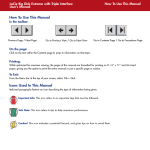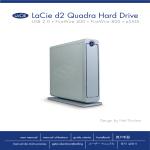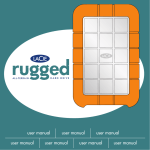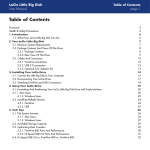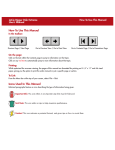Download LaCie DT FIREWIRE 800 PCI CARD/3 PORTS
Transcript
LaCie FireWire 800 PCI Card User’s Manual How To Use This Manual page i How to Use This Manual In the toolbar: Previous Page / Next Page Go to Previous View / Go to Next View Go to Contents Page / Go to Precautions Page On the page: Click on the text within the Contents page to jump to information on that topic. Click on any red text to automatically jump to more information about that topic. Printing: While optimized for onscreen viewing, the pages of this manual are formatted for printing on 8 1/2” x 11” and A4 sized paper, giving you the option to print the entire manual or just a specific page or section. To Exit: From the Menu bar at the top of your screen, select: File > Quit. LaCie FireWire 800 PCI Card User’s Manual Foreword page 1 Copyrights Copyright © 2003 LaCie. All rights reserved. No part of this publication may be reproduced, stored in a retrieval system, or transmitted in any form or by any means, electronic, mechanical, photocopying, recording or otherwise, without the prior written consent of LaCie. Trademarks Apple, Mac, Macintosh and FireWire are registered trademarks of Apple Computer, Inc. Sony and iLink are registered trademarks of Sony Electronics. Microsoft, Windows 98SE, Windows Millennium Edition, Windows 2000 and Windows XP are registered trademarks of Microsoft Corporation. Other trademarks mentioned in this manual are the property of their respective owners. Changes The material in this document is for information only and subject to change without notice. While reasonable efforts have been made in the preparation of this document to assure its accuracy, LaCie assumes no liability resulting from errors or omissions in this document, or from the use of the information contained herein. LaCie reserves the right to make changes or revisions in the product design or the product manual without reservation and without obligation to notify any person of such revisions and changes. FCC Statement: Warning! Modifications not authorized by the manufacturer may void the user’s authority to operate this device. NOTE: This equipment has been tested and found to comply with the limits for a Class A digital device, pursuant to Part 15 of the FCC Rules. These limits are designed to provide reasonable protection against harmful interference when the equipment is operated in a commercial environment. This equipment generates, uses, and can radiate radio frequency energy and, if not installed and used in accordance with the instruction manual, may cause harmful interference to radio communications. Operation of this equipment in a residential area is likely to cause harmful interference in which case the user will be required to correct the interference at his own expense. NOTE: This equipment has been tested and found to comply with the limits for a Class B digital device, pursuant to Part 15 of the FCC Rules. These limits are designed to provide reasonable protection against harmful interference in a residential installation. This equipment generates, uses and can radiate radio frequency energy and, if not installed and used in accordance with the instructions, may cause harmful interference to radio communications. However, there is no guarantee that interference will not occur in a particular installation. If this equipment does cause harmful interference to radio or television reception, which can be determined by turning the equipment off and on, the user is encouraged to try and correct the interference by one or more of the following measures: • Reorient or relocate the receiving antenna. • Increase the separation between the equipment and receiver. • Connect the equipment into an outlet on a circuit different from that to which the receiver is connected. • Consult the dealer or an experienced radio/TV technician for help. LaCie FireWire 800 PCI Card User’s Manual Foreword Canada Compliance Statement This Class A digital apparatus meets all requirements of the Canadian Interference-Causing Equipment Regulations. Manufacturer’s Declaration for CE Certification We, LaCie, solemnly declare that this product conforms to the following European standards: Class B EN60950, EN55022, EN50082-1, EN61000-3-2 With reference to the following conditions: 73/23/EEC Low Voltage Directive 89/336/EEC EMC Directive page 2 LaCie FireWire 800 PCI Card User’s Manual Health and Safety Precautions page 3 Health and Safety Precautions Only qualified persons are authorized to carry out maintenance on this device. • Read this User's Guide carefully, and follow the correct procedure when setting up the device. • Do not attempt to disassemble or modify your PCI card. Never insert any metallic object into the circuitry to avoid any risk of electrical shock, fire, short-circuiting or dangerous emissions. Your PCI card contains no user-serviceable parts. If it appears to be malfunctioning, have it inspected by a qualified LaCie Technical Support representative. • Never expose your device to rain, or use it near water, or in damp or wet conditions. Never place objects containing liquids on the PCI card, as they may spill onto its circuitry. Doing so increases the risk of electrical shock, short-circuiting, fire or personal injury. • Make sure that the computer and PCI card are electrically grounded. If the devices are not grounded, there is an increased risk of electrical shock. • Do not expose the PCI card to temperatures outside the range of 5° C to 45° C (41° F to 104° F). Doing so may damage the card or disfigure its casing. Avoid placing your card near a source of heat or exposing it to sunlight (even through a window). Inversely, placing your card in an environment that is too cold or humid may damage the unit. LaCie FireWire 800 PCI Card User’s Manual Health and Safety Precautions 1. Introduction 1.1 Icons Used In This Manual 1.2 What Is FireWire? 2. Installing Your LaCie FireWire 800 PCI Card 2.1 Minimum System Requirements 2.2 Electrostatic Discharge 2.3 FireWire Card Installation 2.3.1 Mac Users 2.3.2 PC Users 2.4 Driver Verification 3. Troubleshooting 4. Contacting Customer Support 4.1 Warranty 5. Appendix 1 – FireWire Questions and Answers 6. Glossary Table of Contents page 4 3 5 5 6 7 7 8 8 8 9 11 12 14 15 16 18 Introduction LaCie FireWire 800 PCI Card User’s Manual page 5 1. Introduction Congratulations on the purchase of your new LaCie FireWire 800 PCI Card. Now when you connect your FireWire devices through your LaCie FireWire 800 PCI Card, you will be able to achieve the impressive transfer rates that FireWire makes possible. The LaCie FireWire PCI Card has three high-speed FireWire ports, giving you a convenient solution to connect more FireWire peripheral devices to your computer, such as high-speed hard drives, digital cameras, scanners and most popular D8 camcorders. Some of the key features include the following: • Compliant to IEEE 1394-1995 and P1394a standards. • Provides Bus master function with OHCI interface specification. • Compliant with the latest PCI 2.2 data bus specification. • Supports 100, 200, 400 and 800 Mb/s data transfer rates. This manual will help you to: • Install your new card properly • Get it up and running 1.1 Icons Used in This Manual Italicized paragraphs feature an icon describing the type of information being given. Important Note Technical Information or News Warning! (This icon indicates potential hazard) Precautions Always follow the basic precautions to use your LaCie FireWire 800 PCI Card safely and correctly. Respecting these guidelines will help to avoid the possibility of personal injury to yourself or others, as well as to prevent damage to your device and other computer equipment. For a complete list of precautions, please see the Health and Safety Precautions of this manual. Warranty LaCie and its suppliers accept no liability for any loss of data during the use of this device, or for any of the problems caused as a result. Manual Updates LaCie is constantly striving to give you the most up-to-date, comprehensive User’s Manuals available on the market. It is our goal to provide you with a friendly, easy-to-use format that will help you quickly install and utilize the many functions of your new device. If your manual does not reflect the configurations of the product that you purchased, please check our Web site for the most current version available. Introduction LaCie FireWire 800 PCI Card User’s Manual page 6 1.2. What Is FireWire? FireWire, also known as IEEE 1394, is a high-speed serial input/output technology for connecting peripheral devices to a computer or to each other, and FireWire 800 is the implementation of the new IEEE 1394b standard. Pushing the speed barrier to new limits, FireWire 800 offers increased bandwidth and extended cabling distance between devices. FireWire 800 is ideal for bandwidth-intensive applications, such as audio, video and graphics. Benefits of FireWire 800 include: • Resourceful architecture: FireWire 800 reduces delays in arbitration and signal distortion, and increases throughput. • Hot-pluggable: devices can be added and removed while the bus is active. • Backwards compatibility: adapter cables allow FireWire 400 devices to operate under the FireWire 800 port. • Isochronous data delivery: no dropped frames – FireWire 800 supports real-time data delivery. • Flexible: up to 63 devices can be connected on a single bus. Please see Appendix 1 – FireWire Questions And Answers for a more detailed discussion of FireWire’s uses and capabilities. FireWire Icons Theses icons will help you easily identify the FireWire interface. They appear on FireWire cables, and next to the FireWire port connectors on certain computers. FireWire icon iLink icon DV icon LaCie FireWire 800 PCI Card User’s Manual Installing Your LaCie FireWire 800 PCI Card page 7 2. Installing Your LaCie FireWire 800 PCI Card 2.1 Minimum System Requirements Hardware Requirements for FireWire 800: • Mac: G4 • PC: Pentium III or higher compatible processor • 128MB RAM or higher • PCI slot that complies with PCI Specification Rev.2.0 or above System Requirements for FireWire 800: • Mac OS 10.2.4 or higher • Windows 2000 and Windows XP Hardware Requirements for FireWire 400: • Mac: G3 or greater, • PC: Pentium II or higher -compatible processor, • 64MB RAM or greater • PCI slot that complies with PCI Specification Rev.2.0 or above System Requirements for FireWire 400: • Mac OS 9.x (Apple FireWire support 2.3.3 and greater) and 10.x • Windows 98 SE, Windows Me, Windows 2000 and Windows XP The LaCie FireWire PCI Card is compliant with the Open Host Controller Interface (OHCI) and the Enhanced Host Controller Interface (EHCI). Important Note: The format of this card is not compatible with laptops or notebook computers, and therefore cannot be installed on these types of systems. Please contact your computer supply specialist for another FireWire option for these kinds of systems. Warning! Before handling and installing your LaCie FireWire PCI Card, ensure that you have properly grounded yourself. Electrostatic Discharge (ESD) can quickly and easily damage or destroy your component or your computer. Please read the following information to properly ground yourself. LaCie FireWire 800 PCI Card User’s Manual Installing Your LaCie FireWire 800 PCI Card page 8 2.2 Electrostatic Discharge (ESD) Static electricity is an electric charge caused by an imbalance of electrons on the surface of a material. When you touch an object and are shocked, this is the transfer of the static charge or the balancing of your charge to that of the object. This exchange is called Electrostatic Discharge or ESD. ESD can cause two different types of damage to computers and peripherals: (1) Catastrophic, which is the complete loss of device functionality, and (2) Latent Defect, where the device is only partially effected, and the device loses part of its productivity and longevity. Because we cannot eliminate the generation of static electricity, it is extremely important to follow the proper steps to ground yourself before handling your LaCie FireWire PCI Card or touching any internal component of your computer. This can be accomplished by proper grounding in conjunction with the use of ESD safe mats, wrist or shoe straps. Consult your computer supply specialist for more details on the correct ESD dissipative device to fit your needs. 2.3 FireWire Card Installation Tools: Philips-head and/or flat-head screw driver Computer System Manual 2.3.1 Mac Users 1) Turn off your computer and disconnect all external peripheral devices and cables, i.e. power cord, modem/fax line, monitor, etc. 2) Remove your computer’s cover by pulling the latch on the side, and gently lower the side of the computer onto a flat, nonabrasive surface. 3) Once you have removed the cover, you will need to locate the PCI slots on the motherboard. The PCI slots are generally located in the back of the computer, with the slots built into the side-wall of the computer (please refer to your computer system’s manual for the exact location of your PCI slots). If necessary, you may need to remove the expansion slot cover, and you may also need to remove any add-in boards which block access to the PCI slots. 4) Take the LaCie FireWire PCI Card out of its anti-static bag and push the card into the empty PCI card slot. The card PCI Slots in Apple G3/G4 LaCie FireWire 800 PCI Card User’s Manual Installing Your LaCie FireWire 800 PCI Card page 9 should be mounted with the circuitry and three FireWire connectors facing down. There is only way to mount the card, so if you are having problems inserting the card into the PCI slot, make sure that it is oriented correctly. Be sure that the gold contact pins of the PCI card are seated completely inside your computer’s PCI slot. Be aware that it may take some force to get the card fully seated in the slot. 5) Once the PCI card is seated correctly, tighten with a screw, and, if necessary, replace any add-in boards that you removed in Step 3. 6) Now you are ready to put the computer’s cover back on and reconnect all of your external peripheral devices and cables. 7) Power on your computer. After the start up procedure has finished, you should be able to connect devices through the available FireWire ports. 2.3.2 PC Users 1) Turn off your computer and disconnect all external peripheral devices and cables, i.e. power cord, modem/fax line, monitor, etc. 2) Remove your computer’s cover. For most computers, there are screws that will need to be unseated before you can remove the computer’s cover, and these screws are usually located at the rear of the computer, along the edge of the cover. However, placement of these screws and cover attachment may vary by manufacturer, so please refer to your computer system’s manual for specific details. 3) Once you have removed the cover, you will need to locate the PCI slots on the motherboard. The PCI slots are generally located in the back of the computer, with the slots built into the side-wall of the computer (please refer to your computer system’s manual for the exact location of your PCI slots – the LaCie FireWire 800 PCI Card may be installed in either a 32 or 64-bit PCI card slot). If necessary, you may need to remove the expansion slot cover, and you may also need to remove any add-in boards which block access to the PCI slots. 4) Take the LaCie FireWire PCI Card out of its anti-static bag and push the card into the empty PCI card slot. The card should be mounted with the circuitry and three FireWire connectors facing down. There is only way to mount the card, so if you are having problems inserting the card into the PCI slot, make sure that it is oriented correctly. Be sure that the gold contact pins of the PCI card are seated completely inside your computer’s PCI slot. Be aware that it may take some force to get the card fully seated in the slot. LaCie FireWire 800 PCI Card User’s Manual Installing Your LaCie FireWire 800 PCI Card page 10 5) Once the PCI card is seated correctly, tighten with a screw, and, if necessary, replace any add-in boards that you removed in Step 3. 6) Now you are ready to put the computer’s cover back on and reconnect all of your external peripheral devices and cables. 7) Power on your computer. After the start up procedure has finished, you should be able to connect devices through the available FireWire ports. Technical Information: Microsoft Windows 98SE Users! After your computer has booted up, Windows 98SE will launch the Found New Hardware prompt, and you will need to follow the Add New Hardware Wizard to properly install the necessary controllers. A) The Add New Hardware Wizard dialog box appears, alerting you that it is searching for new drivers for: PCI OHCI Compliant IEEE 1394 Host Controller. Click Next. B) At the next window, check the circle for “Search for the best driver for your device (Recommended)” and click Next. C) The next dialog box will search for new drivers from its internal driver database on the hard drive. Cancel all of the other options in the list and click Next. D) This dialog box shows that the Wizard is ready to install the best driver for the device. Click Next. The files should load automatically from the Windows driver database in several seconds. Important Note: If the Add New Hardware Wizard prompts you that a specific, required driver file could not be found, it will then prompt you to insert the Windows 98SE CD-ROM into your computer to load the new driver. Follow the prompts until the correct driver has been located. E) At the final window, click the Finish button to complete the driver installation. You will then need to restart your computer to load the driver properly. LaCie FireWire 800 PCI Card User’s Manual Installing Your LaCie FireWire 800 PCI Card page 11 2.4 Driver Verification Windows 98 SE & Me Users: From the Start menu, click on Settings, and then open the Control Panel. From the Control Panel, click on System, and then click on the Device Manager button. In the list that follows, you should see the following: 1394 Bus Controller. If you click on the + sign beside 1394 Bus Controller, the following should then be listed: PCI OHCI Compliant IEEE 1394 Host Controller. If there is an “X” or “!” besides this entry, there is a conflict, and you will need to consult the Windows Help System to solve the problem. Windows 2000 Users: From the Start menu, click on Settings, and then open the Control Panel. From the Control Panel, click on System, and then click on the Hardware tab. At the next window, click on the Device Manager button. In the list that follows, you should see the following: 1394 Bus Controller. If you click on the + sign beside 1394 Bus Controller, the following should then be listed: PCI OHCI Compliant IEEE 1394 Host Controller. If there is an “X” or “!” besides this entry, there is a conflict, and you will need to consult the Windows Help System to solve the problem. If you cannot see the device, retry the installation procedure and try the other troubleshooting solutions listed here. Mac Users: Open Apple System Profiler and click on the Devices and Volumes tab. If your device is not listed, retry the installation procedure and try the other troubleshooting solutions listed here. Troubleshooting LaCie FireWire 800 PCI Card User’s Manual page 12 3. Troubleshooting In the event that your LaCie FireWire PCI Card is not working correctly, please refer to the following checklist to find out where the problem is coming from. If you need further assistance, please contact LaCie Technical Support (see 4. Contacting Customer Support for details). The Problem Questions to Ask Possible Solutions Your system will not boot or start properly. Is the card properly installed? Double-check the installation procedure and make sure that the card is fully seated in the PCI slot. If this still does not solve the problem, try installing the card in another PCI slot. The “1394 Bus Controller” does not appear in the Device Manager. Is the card properly installed? Double-check the installation procedure and make sure that the card is fully seated in the PCI slot. If this still does not solve the problem, try installing the card in another PCI slot. If you are running Windows 98SE, did you follow the correct driver installation procedures? Re-install the card and then repeat the driver installation procedures. Are you running Windows 95 or Windows 98? These systems do not support FireWire devices. See section 2.1 Minimum System Requirements for a complete list of supported operating systems. Troubleshooting LaCie FireWire 800 PCI Card User’s Manual The Problem page 13 Questions to Ask Possible Solutions Bus-powered devices are not working when connected through the new PCI card. What kind of power requirements does your device have, and how many devices are connected to your card? Check to see that your card has the optional power cable attached. With the optional power supply connected, each FireWire 800 port can provide up to 18 W of power. If the power supply is not connected, then the 18 W is shared by the three ports, effectively assigning 6 W per port. Check to ensure that your device is supported by the power output provided by the card. Your LaCie FireWire 800 PCI Card provides up to 18 Watts of power for external devices. Difficulties connecting a D8 or Digital Video (DV) camera. Is the camera listed in System Properties? Follow the steps in section 2.4 Driver Verification to get to the Device Manager. In the Device Manager list, click on the + sign beside Imaging Device, and you should see Microsoft DV camera and VCR. If you do not see this, the camera is not properly connected to the FireWire card. Re-establish your connection and see if the device is then listed. Did you install all the necessary information for your DV camera? Please refer to your DV camera’s documentation for more information. Is the DV camera properly connected to the FireWire card? Check to make sure that the FireWire cable is properly seated in one of the available FireWire ports on the FireWire card, and that the other end is securely seated in the camera. Contacting Customer Support LaCie FireWire 800 PCI Card User’s Manual page 14 4. Contacting Customer Support Before You Contact Technical Support 1) Read the manual and review the Troubleshooting section. 2) Try to isolate the problem. If you have asked yourself all of the pertinent questions in the troubleshooting checklist, and you still can't get your LaCie FireWire 800 PCI Card to work properly, contact us via the provided Web link. Before contacting us, make sure that you are in front of your computer and that you have the following information on hand: 1) Your card's serial number 2) Computer brand and model 3) Operating system and version (i.e. Windows 98 SE, etc.) 4) Amount of memory installed 5) Names of CD or DVD drives installed on your computer 6) Names of any other devices installed on your computer LaCie Technical Support LaCie Australia LaCie Belgium LaCie Canada Contact Us At: Contact Us At: Contact Us At (English): http://www.lacie.com/au/contact/ http://www.lacie.com/be/contact/ http://www.lacie.com/caen/contact/ LaCie Denmark Contact Us At: http://www.lacie.com/dk/contact/ LaCie Finland Contact Us At: http://www.lacie.com/fi/contact LaCie France Contact Us At: http://www.lacie.com/fr/contact/ LaCie Germany Contact Us At: http://www.lacie.com/de/contact/ LaCie Italy Contact Us At: http://www.lacie.com/it/contact/ LaCie Japan Contact Us At: http://www.lacie.co.jp LaCie Netherlands Contact Us At: http://www.lacie.com/nl/contact/ LaCie Norway Contact Us At: http://www.lacie.com/no/contact/ LaCie Spain Contact Us At: http://www.lacie.com/es/contact/ LaCie Sweden Contact Us At: http://www.lacie.com/se/contact/ LaCie Switzerland Contact Us At: http://www.lacie.com/chfr/contact LaCie United Kingdom & Ireland Contact Us At: http://www.lacie.com/uk/contact/ LaCie USA Contact Us At: http://www.lacie.com/contact/ LaCie Grand Export Contact Us At: http://www.lacie.com/intl/contact/ LaCie FireWire 800 PCI Card User’s Manual Warranty page 15 4.1 Warranty LaCie warrants your PCI card against any defect in material and workmanship, under normal use, for the period designated on your warranty certificate. In the event this product is found to be defective within the warranty period, LaCie will, at its option, repair or replace the defective PCI card. This warranty is void if: • The card was operated/stored in abnormal use or maintenance conditions; • The card is repaired, modified or altered, unless such repair, modification or alteration is expressly authorized in writing by LaCie; • The card was subjected to abuse, neglect, lightning strike, electrical fault, improper packaging or accident; • The card was installed improperly; • The serial number of the card is defaced or missing; LaCie will not, under any circumstances, be liable for direct, special or consequential damages such as, but not limited to, damage or loss of property or equipment, loss of profits or revenues, cost of replacement goods, or expense or inconvenience caused by service interruptions. Under no circumstances will any person be entitled to any sum greater than the purchase price paid for the card. To obtain warranty service, call LaCie Technical Support. You may be asked to furnish proof of purchase to confirm that the card is still under warranty. All cards returned to LaCie must be securely packaged in their original box and shipped with postage prepaid. Register online for free technical support: www.lacie.com/register.htm LaCie FireWire 800 PCI Card User’s Manual Appendix page 16 5. Appendix – FireWire Questions & Answers What Does IEEE 1394 Mean? IEEE (the Institute of Electrical and Electronics Engineers) refers to the engineering corps that developed the 1394th standard, defining the high-performance serial input/output (I/O) bus used to connect peripheral devices. There are now two standards: IEEE 1394a, which refers to the original standard adopted in 1995, and IEEE 1394b, which refers to the new standard, adopted in 2002. What Is The Relationship Between IEEE 1394, FireWire, iLink And DV? These four names all refer to the same interface: • IEEE 1394 is the term commonly used in the computer industry. • FireWire is the brand name used by Apple. • iLink is the brand name used by Sony for both consumer electronics and personal computers. • DV is short for “Digital Video,” and is used as the logo for the interface on most video camcorders. What Are The Benefits Of The FireWire Interfaces? The FireWire interface is a fast, cross-platform serial bus, and is ideal for digital audio, video and graphic applications that demand plenty of bandwidth. Both versions of FireWire offer Plug & Play connectivity, so all you have to do is plug in your drive and begin using it, they also allow up to 63 devices to be connected via a single bus and offer peer-to-peer connectivity, enabling multiple computers and FireWire devices to be connected at the same time. FireWire also supports both isochronous and asynchronous capabilities, meaning that it can guarantee real-time data delivery, so there is no danger of inaccurately ordered or delayed frames. What Is The Difference Between FireWire 400 And FireWire 800? Essentially, the main difference between the two interfaces can be summed up in one word: speed. FireWire 800 effectively doubles the bandwidth of the original FireWire 400 interface. The new FireWire 800 interface offers truly impressive results, with speeds up to 800Mb/s for a single bus, and even greater for several buses in RAID0 configurations. Other key advancements include the support of increased cabling distances and a newly enhanced arbitration architecture. Utilizing cables constructed of professional-grade glass optical fiber, when both devices are connected via a FireWire 800 hub, FireWire 800 can burst data across 100 meters of cable. The new arbitration scheme greatly improves on the existing architecture by incorporating advanced 8B10B data encoding (based on codes used by Gigabit Ethernet and Fibre Channel), which reduces signal distortion, and also improves the arbitration time by prepping the arbitration while the current data packet is being sent, so that data is sent as soon as the current transmission is completed. What Are The Ideal Uses For FireWire? FireWire helped fuel a revolution for digital content creators, and was awarded a 2001 Primetime Emmy Engineering Award by the Academy of Television Arts & Sciences for its contribution. Due to its high bandwidth and support of both isochronous LaCie FireWire 800 PCI Card User’s Manual Appendix page 17 and asynchronous data delivery, FireWire has found a very successful place in both the computer and consumer electronics industries. Whether connecting game consoles, personal video recorders, home stereo equipment, digital TVs, hard drives, CD/DVD-RW drives, printers, scanners, tape drives or other digital hardware equipment, FireWire is well-suited to handle all these various requirements. With the advent of the new FireWire 800 standard, the revolution created by the original will only grow. For those working with digital video, the new standard will enable new bandwidth-intensive applications, such as multiple-stream, uncompressed, standard-definition video. Will FireWire 400 Devices Run Faster When Connected To A FireWire 800 Port? Unfortunately, this is not the case. In order to attain FireWire 800 speeds, both the device and port have to be FireWire 800 enabled. For instance, an external hard drive with a FireWire 800 9-pin connection will only reach FireWire 800 transfer rates when it is connected to a FireWire 800 9-pin host bus adapter card via a properly certified FireWire 800 9-pin to 9-pin beta cable. When a FireWire 400 device is connected to a FireWire 800 port, the FireWire 400 device will only operate at the original FireWire 400 speeds. Will FireWire 800 Devices Work On FireWire 400 Ports And Vice Versa? The new standard was designed to be backwards compatible, meaning that FireWire 800 devices will still operate via the original FireWire 400 port. To connect a FireWire 800 device to a FireWire 400 port, a specific adapter cable must be used, though. There are two types of FireWire 400 ports: 6-pin and 4-pin. For FireWire 800 devices to work, they must be connected by placing the 9-pin end of the FireWire cable into the FireWire 800 port of the device, and the opposite 6-pin or 4-pin end into the FireWire 400 port. The same holds true for FireWire 400 devices being connected to a FireWire 800 host port. The 4-pin or 6-pin end of the FireWire cable must be connected to the FireWire 400 port of the device, and the 9-pin end must be connected to the FireWire 800 port. When FireWire 400 and FireWire 800 devices are mixed, all transfer rates revert to the original FireWire 400 speed. What Do I Do If My Computer Does Not Have A FireWire Port? Most computers manufactured today incorporate at least one FireWire port. If your computer does not have a native port, you can install one by adding a PCI or PCMCIA host bus adapter card. Please contact your computer supply specialist for a specific card that will work with your system. For more information about the FireWire interface, please visit: http://www.lacie.com/technologies LaCie FireWire 800 PCI Card User’s Manual Glossary page 18 6. Glossary Asynchronous – Data transfer method where the data is transferred independently of other processes. With this transfer method, the intervals between transmissions can vary, and data can be resent if it is initially missed. Backup – (1) The act of creating at least one additional copy of data onto a different (and safe) storage device from where it can be retrieved at a later time if needed. (2) A copy of a file, directory, or volume on a separate storage device from the original, for the purposes of retrieval in case the original is erased, damaged, or destroyed. Bit – The smallest measure of computerized data, either a 1 or a 0. Eight bits equal one byte, or one character. Block – A very small section of the storage media comprised of one or more sectors. A block is the smallest amount of space allocated on a drive for data storage. By default, a sector of data consists of 512 bytes. Buffer – RAM cache that is faster than the data that is being delivered. Buffers are used so data may be stored and delivered to the receiving item as it is needed. Bus – Electronic links that enable data to flow between the processor, RAM and extension cables (peripherals). Byte – A sequence of adjacent binary digits, or bits, considered as a unit, 8 bits in length. There are 8 bits in 1 byte. See also MB (Megabyte) or GB (Gigabyte). Cache, -ing – This is an area of electronic storage (usually RAM) set aside to store frequently used data from electromechanical storage (hard drives, floppy disks, CD/DVD-ROM, tape cartridges, etc.) Therefore, storing frequently used data in RAM can enhance your system’s overall response to disk-intensive operations significantly. Configuration – When talking about a PC, configuration is understood to be the sum of the internal and external components of the system, including memory, disk drives, the keyboard, the video subsystem and other peripherals, such as the mouse, modem or printer. The configuration also implies software: the operating system and various device managers (drivers), as well as hardware settings and options set by the user via configuration files. Controller – This is a component or an electronic card (referred to in this case as a "controller card") that enables a computer to communicate with or manage certain peripherals. The controller manages the operation of the peripheral associated with it, and links the PC bus to the peripheral via a ribbon cable inside the PC. An external controller is an expansion card which fills one of the free slots inside your PC and which enables a peripheral (CD-ROM drive, scanner or printer, for instance) to be connected to the computer. Cross-platform – Term that refers to a device that is able to be operated by both Mac and Windows operating systems. Data Stream – The flow of data that accomplishes a task, usually related to moving data from storage to computer RAM or between storage devices. LaCie FireWire 800 PCI Card User’s Manual Glossary page 19 Digital – Discrete information that can be broken down to zero or one bits. Driver (peripheral manager) – A software component that enables the computer system to communicate with a peripheral. Most peripherals will not operate correctly – if at all – if the appropriate drivers are not installed on the system. File System – Links the physical map of a disc to its logical structure. Thanks to the file system, users and computers can easily display path, directories and files recorded onto the disc. Firmware – Permanent or semi-permanent instructions and data programmed directly into the circuitry of a programmable read-only memory or an electronically-erasable, programmable read-only memory chip. Used for controlling the operation of the computer or tape drive. Distinct from the software, which is stored in random access memory and can be altered. Folder – A list created on a disk to store files. Creating folders and sub-folders enables you to organize the storage of your files in a logical, hierarchical manner so that you can find and manage them more easily. Format, -ting, -ted – This is a process where a device is prepared to record data. In this process, the hard disk writes special information onto its own recording surfaces into areas (blocks) that are ready to accept user data. Since this operation causes all current user data stored on the hard disk to be lost, this is an infrequent operation that usually only happens at the factory that created the hard disk. It is unusual for something to happen to a hard disk that requires the end-user to initially perform this operation. GB (GigaByte) – This value is normally associated with data storage capacity. Basically, it means a thousand million or a billion bytes. In fact, it equals 1,073,741,824 bytes (or 1,024 x 1,024 x 1,024). Hardware – Physical components of a computer system, including the computer itself and peripherals such as printers, modems, mice, etc. Host Bus Adapter (HBA) – A printed circuit board that installs in a standard microcomputer and an interface between the device controller and the computer. Also called a controller. Initialize, -ed, Initialization – After a hard drive (or other storage device) is formatted and partitioned, some special data needs to be written to it that helps the Mac and Windows create files and save data. The process is called initialization. This process, like formatting, causes all user data on the storage device to be lost. Interface – The protocol data transmitters, data receivers, logic and wiring that link one piece of computer equipment to another, such as a hard drive to an adapter or an adapter to a system bus. Protocol means a set of rules for operating the physical interface, such as: do not read or write before the drive is ready. I/O (Input/Output) – Refers to an operation, program or device whose purpose is to enter data into or to extract data from a computer. LaCie FireWire 800 PCI Card User’s Manual Glossary page 20 Isochronous – Data transfer method that ensures that data flows continuously and at a steady rate. These transfers provide guaranteed transmission opportunities at defined intervals. Kb (Kilobit) – Equivalent to 1,000 bits. Kb/s – Kilobits per second. 480Kb/s is equal to 60KB/s. KB (KiloByte) – Basically, this means 1,000 bytes, but it is actually 1,024 bytes. KB/s – Kilobytes per second. A means of measuring throughput. Mb (Megabit) – Equivalent to 1,000,000 bits. Mb/s – Megabits per second. A means of measuring throughput. 480Mb/s is equal to 60MB/s. MB (Megabyte) – Basically means one million bytes, but is actually 1,024 Kilobytes or 1,024 x 1,024 bytes, which equals 1,048,576 bytes. MB/s – Megabytes per second. A means of measuring throughput. Media – The material or device used to store information in a storage subsystem, such as a tape cartridge, CD, DVD or disk drive. Operating System (OS) – Software that controls the assignment and use of hardware resources such as memory, processor time, disk space and peripherals. An operating system is the basis on which software (applications) run. Windows, Mac OS and UNIX are among the most common. Overwrite – To write data on top of existing data thus erasing the original data. Partition, -ing – After formatting, the hard drive is not yet ready to store files. It must be divided into sections that will contain special information required for a Mac or PC to operate and other sections that will contain the files. This process of dividing up the hard drive is called partitioning. A partition is just one section of the hard drive that will contain either special data put there by Silverlining or other files and data. Peripheral – A generic term applied to printers, scanners, mice, keyboards, serial ports, graphics cords, disk drives and other computer subsystems. This type of peripheral often relies on its own control software, known as a peripheral driver. Port, hardware – A connection component (SCSI port, for example) that enables a microprocessor to communicate with a compatible peripheral. Port, software – A memory address that identifies the physical circuit used to transfer information between a microprocessor and a peripheral. LaCie FireWire 800 PCI Card User’s Manual Glossary page 21 RAM (Random Access Memory) – Generally referred to as a computer’s “memory.” An integrated circuit memory chip that allows information to be stored and retrieved by a microprocessor or controller. The information can be stored or accessed in any order, and all storage locations are equally accessible. Seek Time – The amount of time (in thousandths of a second, or milliseconds) that it takes a hard drive’s read/write head to move to a specific location on the disk. Average seek, then, is the average of a large number of random samplings all over the disk. Seek time is CPU independent, meaning that seek time is the same for a disk drive, whether it is attached to a computer or not. Software – In a nutshell, software is a set of instructions for the computer. A set of instructions to perform a particular task is called a program. There are two main types of software: system software (an operating system such as Mac OS or Windows) which controls the operation of the computer and application software (programs such as Word or Excel) which enable users to perform tasks such as word processing, spreadsheet creation, graphics, etc. Storage – In computers, any equipment in which information may be kept. PCs generally use disk units and other external storage media (diskettes, CD-ROMs, magnetic disks, etc.) for permanent storage of information. Striping – Spreading data evenly over multiple disk drives to enhance performance. Data striping can be performed on a bit, byte or block basis for optimum application performance. Transfer Rate – The rate at which the drive sends and receives data from the controller. Transfer rates for reading data from the disk drive may not be the same as the transfer rate for writing data to the disk drive. Transfer rates are CPU dependent, meaning that regardless of how great a transfer rate your drive is capable of, the actual transfer rate can only be as fast as the slowest of your hard drive and computer. Volume – A desktop mountable storage area, may be a partition of a hard drive, a removable disk or a cartridge. Typically measured in Megabytes or Gigabytes. Utility – Software designed to perform maintenance tasks on the system or its components. Examples include backup programs, programs to retrieve files and data on disk, programs for preparing (or formatting) a disk or and resource editors.






















